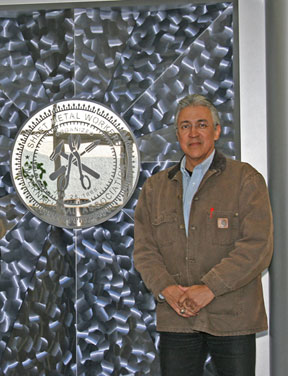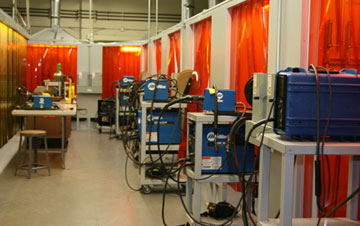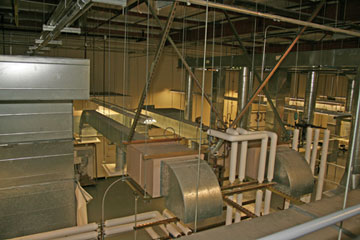Local 104's Sheetmetal Worker's Union Training Center Churns Out Highly-Trained Sheet Metal Workers
Print Article
60,000 sq.-ft. facility trains workers on today's latest equipment - from welders to plasma cutters - to ensure that it produces a skilled workforce to meet the industry's changing needs.
The Hellwig Company offers complete mechanical, process piping and plumbing systems for customers in northern California’s pharmaceutical, computer, aerospace and biotech industries, among others. These high-tech companies have exacting standards. To assure their customers that it can meet those standards requires a pool of highly trained sheet metal workers. For that, it turns to the Sheet Metal Workers Union.
“I think we probably have one of the best training programs in the United States,” says Eldon Shreve, vice president of Hellwig Mechanical, Santa Clara, Calif. “The San Jose training center [Local 104 of the Sheetmetal Worker’s Union] is probably the top state-of-the-art training facility for unionized sheet metal workers in the country,” says Shreve.
 |
| Javier Campos, Administrator for the Sheet Metal Workers Bay Area Industry Training Fund, helps ensure that the union remains at the leading edge of training and technology. |
The training center Shreve speaks of is a 60,000-sq.-ft. facility. Built in 2003, it has nine computer classrooms, five fabrication shops, a clean room, a welding lab and a TAB (testing, adjusting and balancing) lab. Here, apprentices go through a 5-year training program (240 hours per year) on their way to becoming journeymen sheet metal workers. There are four different apprenticeship programs operating: one in sheet metal fabrication and installation, one in residential fabrication and installation, one in air conditioning servicing and one in TAB.
The training program, as with all locals’ programs, is associated with a local college, and apprentices receive college credit for some of their work.
It’s not an easy program to get into. Applicants must first pass a math test to be considered, and only the top scorers are considered. However, the program has one of the highest retention rates of any of the skilled trades, with 80 to 85 percent of the apprentices completing the program. To be successful in sheet metal work, you need to know geometry, trigonometry and, in some cases, physics and thermodynamics, notes Javier Campos, Administrator for the Sheet Metal Workers Bay Area Industry Training Fund.
“People are really amazed at the things that go into our industry,” said Campos. “Most people just see a thermostat on the wall and they don’t know what goes on behind the scenes. Sheet metal workers have more extensive training in comparison to some of the other crafts. It’s more of a technical trade and the only one that builds, installs and services its own components.”
 |
| Local 104’s welding lab relies on a variety of Miller welding equipment. XMT 304 inverters are chosen for their reliability, operator friendliness, arc quality and multi-process performance to train. Recently introduced, Millermatic Passports (foreground) provide a highly portable, all-on-one MIG welding solution. Because apprentices can expect to find them in the field, they train on them in school. |
In addition to ensuring that their workers have the skills to meet the industry’s evolving needs, the union also ensures that its workers are trained on the latest equipment, which allows their industry to gain the benefits of the most up-to-date equipment.
“Contractors don’t want to go out and buy a new piece of equipment and not have trained personnel to run it,” says Campos “But more contractors are getting new equipment, such as plasma cutters, because they know our students are getting exposed to them in our training center. They’re getting those skills. Now it makes sense for the contractor to purchase a plasma cutter because he won’t have to take the time to train his people on the equipment.”
 |
| Testing, adjusting and balancing (TAB) an HVAC system ensures that heated, cooled or filtered air flows as intended. |
This symbiotic relationship between the mechanical contractor and union flourishes with the involvement of equipment companies that are in touch with and responsive to the industry’s unique needs.
“In my opinion, in the many years we been associated with Miller Electric, the guys at Miller have taken the time to understand what we do so they can design products that match our needs,” says Campos. “They ask all the right questions, and we see the results in the products they produce. Miller has done a good job taking the time to learn how we operate and to work with us to develop new products. You see that in products such as the Millermatic Passport [a portable all-in-one MIG welder with an internal shielding gas cylinder] and the Spectrum 375 X-TREME [an 18-lb. portable plasma cutter].”
Like the computers and software that are part of the sheet metal workers’ training, welding and cutting technology have evolved quickly, especially in reduced size and increased portability. The ongoing relationship between the Sheet Metal Workers Union and companies such as Hellwig and Miller ensure the sheet metal industry, the tools and techniques will all continue to advance at the same pace.